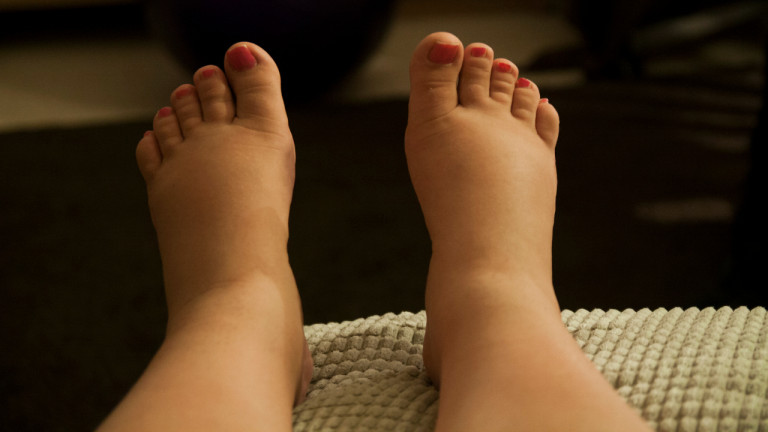
Researchers with The Ohio State University College Of Medicine, The Ohio State University Wexner Medical Center and Nationwide Children’s Hospital discovered a simple urine test which may add some ease in the difficult diagnosis of preeclampsia, one of the world’s most deadly pregnancy-related conditions affecting up to 8% of pregnant mothers today.
This simple “sample in/answer out” urine test, otherwise known as the Congo Red Dot Diagnostic Test (CRD), was piloted in a medical study at Ohio State Wexner Medical Center. And according to Dr. Kara Rood, lead author on the study and maternal-fetal medicine physician at Ohio State Wexner Medical Center, this mechanism is already proving superior when compared to other tests used to diagnose preeclampsia.
“As part of the study, we compared it to our current tests, which include a 24-hour urine collection, the urine dip-stick, or the urine protein-creatinine ratio, and it actually out-performed all of those tests,” Rood tells Scary Mommy.
Preeclampsia is a serious pregnancy-related complication defined by high blood pressure, which may have been previously normal, and signs of damage to another organ’s system. More specifically, usually the liver or kidneys.
If organs become damaged, the body will not be able to process protein properly, thus leading excess protein to secrete into the urine. If excess protein is found in labs, this would suggest preeclampsia.
But according to Rood, preeclampsia is a progressive condition, which can sometimes make the diagnosis mysterious or difficult to diagnose.
“While other tests identify protein, they don’t identify the unique mis-folded protein that’s found in the urine of women with preeclampsia,” Rood tells Scary Mommy.
The CRD test does identify this specific protein. Much like adding water to ink on a piece of paper would cause the ink to disperse throughout the page, the red-dye test works much like that as well. If the specific protein is found in an expecting mother’s urine, the ink-dot spreads and runs along the paper of the test. If the protein isn’t detected in the urine when hitting the dye, the dye stays in the same dot-like shape.
In the study headed by Rood and her team, researchers enrolled 346 pregnant women who were all being evaluated for high blood pressure and possible preeclampsia. Of those women, eighty-nine percent were diagnosed with preeclampsia. And of those diagnosed, 79% were induced with an average delivery at 33 weeks gestation.
The test proved superior to other diagnostics tests with an accuracy rate of 86%.
It’s crucial that, should preeclampsia be suspected, it’s diagnosed as soon as possible. If left untreated, it could lead to HELLP syndrome or eclampsia — the final stage of preeclampsia causing an onset of seizures. If eclampsia occurs, urgent medical care is needed right away as it could be fatal for both the mother and her baby.
With both preeclampsia and eclampsia, many say that the only cure is delivery. But even then, some symptoms may stretch into the postpartum days as well. And since preeclampsia is a progressive condition, with each individual differing in their rates of progression, sometimes mild preeclampsia can be monitored without the need for an early delivery.
Then again, sometimes this isn’t the case, so it leads physicians to go with a “better safe than sorry” approach because of preeclampsia’s unpredictable and dangerous nature.
“Because preeclampsia doesn’t have a gold standard test right now, we, as providers, probably err on the side of caution with more, earlier deliveries,” Dr. Rood tells Scary Mommy.
If providers were better able to diagnose this condition, Rood says that we would potentially see a decrease in the amount of pre-term births, neonatal morbidities, and financial costs.
America doesn’t see many maternal mortalities associated with preeclampsia and eclampsia when compared to the rest of the world, but they do still happen.
Ninety-nine percent of maternal mortalities happen in developing countries, and the World Health Organization estimates the incidence of preeclampsia is seven times higher in developing countries versus developed countries.
With this new test being one-third of the way through its clinical trial with the FDA, Dr. Rood believes the CRD test will prove most beneficial in underdeveloped countries.
“I think in underdeveloped countries, maternal mortality would be the biggest outcome we hope to improve,” Rood explains to Scary Mommy.
Underdeveloped countries don’t have the same advantages in their medical care as developed countries. Most women aren’t seen in a hospital for any of their prenatal care. And it’s not out of the ordinary for deliveries to take place at home in an unlicensed and under-qualified setting without the proper medical necessities should life-saving measures be needed.
Rood’s team is also hopeful that the affordability of this three-minute test will minimize the amount of people referred to larger hospitals in underdeveloped countries who maybe don’t need to be there. There is a major lack of medical resources, so this could help mainstream the people who truly need medical attention in a timely fashion or the outcomes could be adverse for them or their baby.
Considering this test’s accuracy, cost, and timely results, it’s not too bold to say that this could potentially change the way physicians diagnose preeclampsia.
An earlier diagnose means better management, more time to establish a plan, lessened preterm inductions and a potential decrease in the rise of neonatal and maternal deaths today. Rood is confident that the findings of this test will have a “huge impact on the health of women and children.”











RSS